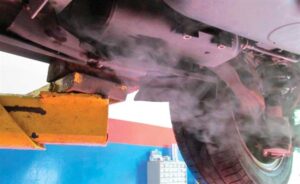
What’s a smoke test you ask?
An EVAP smoke test procedure usually entails a technician clamping the end of the EVAP hose that leads to the charcoal canister and applies pressure on the gas tank using nitrogen via the EVAP test device.
An emissions test is a test conducted on vehicles to check for pollutant emissions produced by the engine of a car. There are generally specific standards a vehicle must pass to be cleared from the emissions test. However, there are times when an engine fails this test. Below are some of the common reasons for failing an emissions test.
Fuel metering out of specification. There are several factors that can cause a fuel metering of your vehicle to be out of specification.
It may be due to a faulty computerized engine control, carburetor, or fuel injection unit
Faulty oxygen sensor. The oxygen sensor in a vehicle measures the amount of oxygen in the exhaust gas. A faulty or defective oxygen sensor is not uncommon and can be caused by several things. A faulty oxygen sensor can lead to other problems including overheating, higher toxic emissions and loss of acceleration power
Defective ignition system. This means that during an HC check, the analyzer detects high Hydrocarbons. If the vehicle is not properly maintained then expect to have an ignition system that is defective causing it to fail an emissions test. The most common causes of high HC are defective spark plugs wires, worn out spark plugs, over advanced ignition timing or a worn out distributor cap
Leaks in the vehicle’s vacuum. Vacuum leaks are another common reason for an emissions test failure. A vacuum leak is often caused by the MAP sensor not working properly. The MAP sensor measures the load of an internal combustion of the engine’s electronic control system. Leaks may be found in the gaskets or vacuum lines of the Rich fuel mixture. High CO2levels are often caused by high carbon monoxide levels due to a weak ignition or a rich air/fuel mixture. There are numerous causes of a rich fuel mixture. A contaminated oxygen sensor, leaky injectors, and excessive fuel pressure are some common causes of richness to the mixture.
Malfunction in the air injection system. The air injection system helps reduce the emission of hydrocarbons and carbon monoxide of a car. This is done by forcing fresh air into the exhaust of the engine. If the air injection system is defective or malfunctions, the engine is not able to properly control the levels of hydrocarbons and carbon monoxide emission causing the car to emit high levels of these dangerous gases
Faulty evaporative emission control system. EVAP or Evaporative Emission Control System prevents gasoline vapors from the fuel system and tank from being released into the atmosphere.
Some of the more common causes of a faulty EVAP include leaks in the vacuum hoses and vents, defective purge valves, or faulty gas caps.

Recent Comments